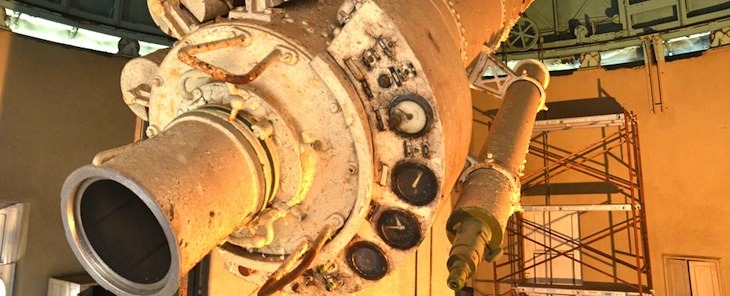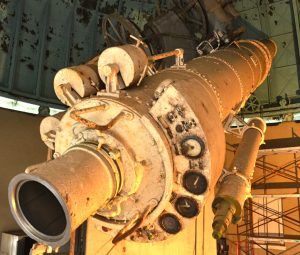Astronomy group to bring historic, 36-foot-long telescope to Arkansas
by April 25, 2017 12:18 pm 1,197 views

Supporting STEM & Space, a Fayetteville-based nonprofit, is raising money to transport from Pennsylvania to Northwest Arkansas a 50,000-pound, antique telescope, donated to the organization by Swarthmore College.
At 36 feet long, with a diameter/aperture of 2 feet, the instrument is tied for the sixth-largest refracting telescope in the U.S., according to a Supporting STEM & Space press release.
Supporting STEM & Space plans to use it as the centerpiece for a STEM (science, technology, engineering and math) education center with a planetarium and observatory. The idea for the facility has been in the works with the organization since its inception two years ago.
“Having this donated means we will likely be able to move forward our final plans probably by several years,” said Katherine Auld, chairman of the board of directors, adjunct faculty member at Northwest Arkansas Community College and NASA/JPL Solar System Ambassador. Auld is hopeful the project will come together soon.
“Let’s see if we can break ground in two years. That’s probably way too ambitious, but I think we should push for it and be ambitious,” Auld said.

An agreement between the organization and Swarthmore College stipulates that the school will pay for disassembling and loading the telescope, while Supporting STEM & Space is tasked with handling transport to Northwest Arkansas. The organization estimates the cost, with insurance, will be about $20,000. Supporting STEM & Space launched a GoFundMe site on Monday (April 24) to help raise money for the effort.
EXOPLANET RESEARCH
Supporting STEM & Space board Vice Chairman Clint Branham, senior systems engineer of cyber security at Wal-Mart Stores, made a trip to see the telescope in person after attending the Northeast Astronomical Forum in nearby Suffern, N.Y. Branham also met with Swarthmore College officials on the trip and spoke with individuals who serviced the telescope in 2005 for an assessment of the requirements to complete the restoration project.
“It is hard to describe how big this telescope is,” Branham said in the press release. “However big you think it is, it’s bigger than that.”
The long‐focus refracting telescope is tied with the 24-inch Clark telescope at Lowell Observatory in Flagstaff, Ariz., as the sixth-largest, according to the release. The tube of heavy sheet steel is bolted to a cast iron centerpiece mount and pier. It is now in a 45‐foot diameter dome at Swarthmore.
The telescope was once used in astronomical photography and by 1974 it had been used to take 100,000 photos on 5‐inch by 7‐inch glass plates. The camera used to create those plates is now in the collection of The Smithsonian Institution, according to Supporting STEM & Space. The telescope was made by the John A. Brashear Company in Pittsburgh in 1911. Originally housed in the Sproul Observatory, it is tied to the earliest claims of the detection of an exoplanet by Peter van de Kamp in 1963, according to the organization.
$250,000 RESTORATION PROJECT
Auld found out a few months ago about the telescope through an email she received as a member of the International Planetarium Society.
Planning to use the building housing the telescope for another purpose, Swarthmore College was accepting proposals for the next phase of the telescope’s life, and once the board of Supporting STEM & Space learned that the college was willing take on the significant cost of disassembling the telescope, the two signed an agreement April 19.
“I am thrilled that Sara Schnecher, committee member of the American Astronomical Society Working Group for the Preservation of Astronomical Heritage, had the vision to find this telescope a new home where it can continue to inspire the people of Northwest Arkansas in their STEM‐focused efforts for years to come,” Auld said in the release.
Supporting STEM & Space plans to restore the telescope to operation, upgrade the control system to work with modern computer systems and use it for public outreach. The organization’s long-term goal is to install the piece in an observatory and science center, although definite plans have not yet been made.
Auld estimates that restoring the telescope to immaculate condition would cost about $250,000. As far as fundraising and building the science center, Auld said: “We will go as far as we can, as quickly we can.”
SMALLER TELESCOPE SUPPORT
In 2016, Supporting STEM & Space launched a local chapter of the Library Telescope Project, which places telescopes available for check out in public libraries, with Bentonville Public Library as the first recipient.
On Sunday (April 23) the organization announced the addition of eight other libraries to receive telescopes, including facilities in Bella Vista, Gravette, Prairie Grove, Springdale, West Fork, Rogers and Fayetteville, according to the organization.
Other Supporting STEM & Space board members include Penny Holland (secretary), sixth‐grade science teacher at Bentonville Public Schools; Blaine Sanders (treasurer), fifth‐grade science teacher at Fayetteville Public Schools and founder of SpareChangeYourLife; Dr. Daniel Barth, assistant professor of STEM (science, technology, engineering and math) education and director of the Astronomy for Educators program at the University of Arkansas; Larry Cooper, high school science teacher at Springdale Public Schools; Dr. Anne Diallo, visiting assistant professor in political science at the UA; Kent Marts, editor and publisher of the weeklies division at Northwest Arkansas Newspapers; Dustin Masterson, cyber security analyst at Walmart; Scott Roberts, founder of Explore Scientific in Springdale; and Kathrine Trovini, delivery driver at Enchanted Designs.
